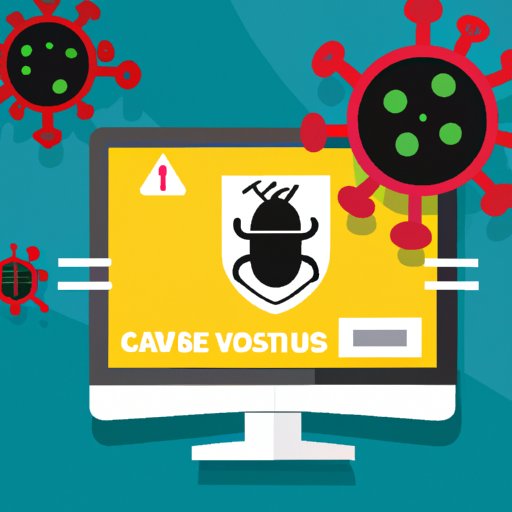Introduction
A computer virus is a type of malicious software that replicates itself and spreads to other computers, often without the user’s knowledge or permission. Viruses can be extremely damaging, potentially corrupting or deleting data, and even causing hardware damage. The threat of viruses has become an increasingly serious concern for computer users around the world, making understanding and protecting against them essential.
A Comprehensive Guide to Computer Viruses: What They Are and How to Protect Against Them
In order to effectively protect against computer viruses, it is important to understand the different types of viruses, the history of these malicious programs, and the methods of prevention and removal.
Exploring the Different Types of Computer Viruses
Computer viruses are classified according to their method of infection and the type of damage they cause. The most common types of computer viruses include:
- Worms: Worms are self-replicating programs that can spread quickly across networks and devices. Unlike viruses, they do not require a host program to attach to in order to spread.
- Trojans: Trojans are malicious programs disguised as legitimate software, usually with the intent of stealing data or granting remote access to a hacker.
- Adware: Adware is a type of malicious program that displays unwanted advertisements on a user’s computer in order to generate revenue for the attacker.
- Spyware: Spyware is a type of malicious program that collects information about a user’s activity without their knowledge or consent.
- Rootkits: Rootkits are malicious programs designed to give attackers full control over a system by hiding their presence and activities.
- Ransomware: Ransomware is a type of malicious program that encrypts a user’s data and requires payment in order to decrypt it.
The History of Computer Viruses: From Malware to Ransomware
The first computer virus was created in 1971 by a computer scientist named John von Neumann. This early virus was designed to replicate itself and spread to other computers, but did not cause any damage. Since then, computer viruses have evolved significantly, becoming much more sophisticated and dangerous. Over the years, the number and variety of computer viruses has grown exponentially, leading to the development of new types of malicious programs such as malware, adware, spyware, rootkits, and ransomware.

An Overview of Computer Virus Prevention Strategies
Preventing computer viruses is essential for protecting one’s computer and data. There are several steps that can be taken to reduce the risk of infection, including:
How to Recognize the Signs of a Computer Virus
It is important to know the signs of a computer virus so that you can take action before it causes too much damage. Some of the most common signs of a computer virus include:
- Unexpected pop-up windows or messages
- Slower than usual computer performance
- Strange files or programs appearing on your computer
- Changes to your web browser settings
- Frequent crashes or freezes
Best Practices for Keeping Your Computer Virus-Free
There are several best practices that should be followed in order to keep your computer virus-free. These include:
- Install and regularly update antivirus software
- Be cautious when opening emails and attachments
- Avoid clicking on suspicious links
- Use strong passwords and two-factor authentication
- Keep your operating system and other software up-to-date
How to Remove a Computer Virus Once It’s Been Detected
If a computer virus has already been detected, there are several methods that can be used to remove it. Some of the most common removal methods include:
Common Removal Methods
- Using antivirus software to scan and remove the virus
- Manually deleting the virus files from the infected computer
- Restoring the computer to a previous state using a backup
- Using a specialist virus removal tool to clean the system
Tips for Effective Removal
When attempting to remove a computer virus, it is important to follow a few basic tips in order to ensure effective removal. These tips include:
- Make sure all other programs and applications are closed
- Disable any real-time protection features in your antivirus software
- Run a thorough scan of your entire system
- Delete or quarantine any infected files
- Reboot your computer after removing the virus
Conclusion
Computer viruses are a serious problem that can lead to significant damage if not properly addressed. It is important to understand the different types of viruses and the methods of prevention and removal in order to keep your computer safe and secure. By following the best practices outlined above, you can greatly reduce the risk of infection and protect yourself from the damaging effects of computer viruses.


